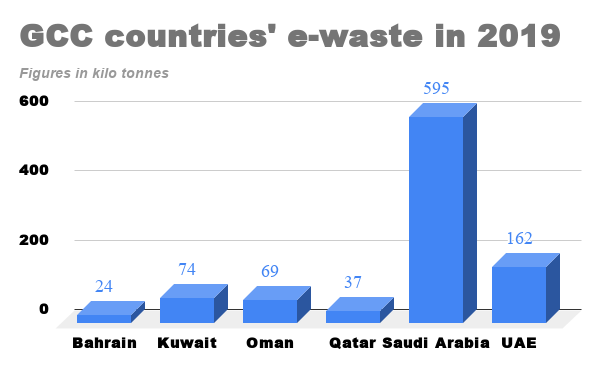E-waste becomes world’s fastest-growing domestic waste stream
Global electronic waste, discarded products with a battery or plug, will grow by 38% from 53.6m metric tonnes (mt) in 2019 to 74.7m mt by 2030, fuelled mainly by higher consumption rates of equipment, short life cycles and few options for repair.
In real terms, the electric and electronic waste in 2019 is equivalent to the weight of 350 cruise ships that have the size of the Queen Mary 2.
According to the UN’s Global E-waste Monitor 2020, the growth in 2019 is up by 21% in just five years and doubling in 16 years by 2030, making e-waste as the world’s fastest-growing domestic waste stream.
Doreen Bogdan-Martin, Director for Telecommunication Development Bureau at International Telecommunication Union (ITU), said that it highlights the pressing issue of e-waste management in today’s digitally connected world.
“Monitoring e-waste streams will contribute to the achievement of the Sustainable Development Goals and tracking the implementation of the ITU Connect 2030 Agenda. The report serves as a valuable resource for governments to improve their global e-waste recycling rate by developing the necessary/needed/required e-waste policies and legislation,” he said.
According to the report, Asia, which includes the Middle East also, generated the greatest volume of e-waste in 2019 — about 24.9 mt, followed by the Americas (13.1 mt) and Europe (12 mt), while Africa and Oceania generated 2.9 mt and 0.7 mt respectively.



Environmental and health issues
Only 17.4% of 2019’s e-waste was collected and recycled, which means that gold, silver, copper, platinum and other high-value, recoverable materials conservatively valued at $57b - a sum greater than the gross domestic product of most countries - were mostly dumped or burned rather than being collected for treatment and reuse.
With the recycling rate of 17.4%, potential raw material value of $10 billion can be recovered from e-waste, and 4 mt of secondary raw materials would become available for recycling.
Statistics on e-waste collected and recycled are based on data reported by countries.
In per capita terms, last year’s discarded e-waste, a health and environmental hazard containing toxic additives or hazardous substances such as mercury, averaged 7.3 kilos for every man, woman and child on earth.
Nikhil Seth, Executive Director at United Nations Institute for Training and Research (UNITAR) & UN Assistant Secretary-General, said that far more electronic waste is generated than is being safely recycled in most parts of the world.
“More cooperative efforts are required to make aware of this increasing issue and take appropriate countermeasures to supplement by appropriate research and training,” he said.
In rich countries, there are large migrant workers that reuse or repair donated used-EEE from the richer households, but this is unique within the region.
Antonis Mavropoulos, President, International Solid Waste Association (ISWA), said that e-waste quantities are rising three times faster than the world’s population and 13% faster than the world’s GDP during the last five years.
“This sharp rise creates substantial environmental and health pressures and demonstrates the urgency to combine the fourth industrial revolution with a circular economy. The fourth industrial revolution either will advance a new circular economy approach for our economies or it will stimulate further resource depletion and new pollution waves,” he said.
from TechRadar - All the latest technology news https://ift.tt/2ZuC2BW
via IFTTT

Comments
Post a Comment